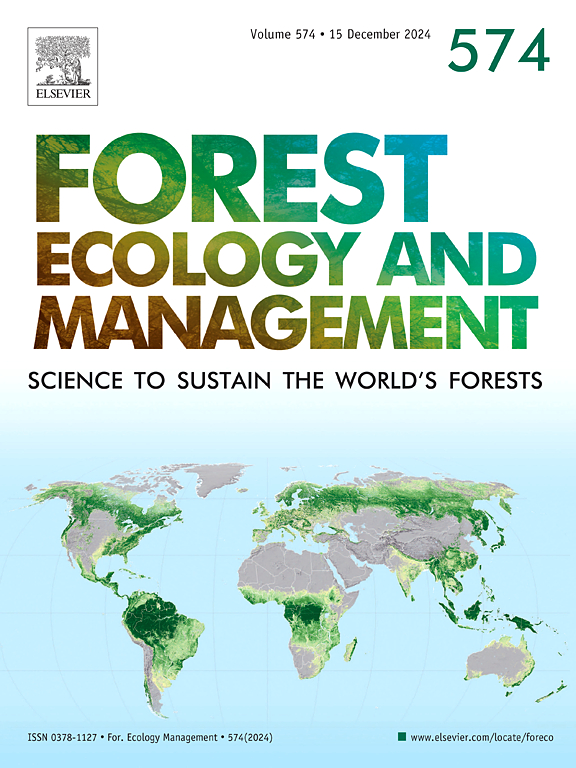东北温带森林阔叶树种叶片倾角及其在树荫耐受性估算中的应用
IF 3.7
2区 农林科学
Q1 FORESTRY
引用次数: 0
摘要
树荫耐受性是树木生存所需的最低光量,对了解森林群落动态、影响物种组成、森林结构和演替过程至关重要。然而,目前估计遮荫耐受性的方法是定性的,可能会产生不可靠的结果。因此,提出一种定量的分类方法势在必行。叶片倾角(LIA)已被公认为是指示树木优化光截获策略的可行参数,并且与遮荫耐受性密切相关。然而,由于无法获得完整的冠层叶片数据,对LIA的充分测量受到了挑战。利用地面激光扫描(TLS)系统的点云数据,对温带森林中23种阔叶树种的林冠高度进行了LIA测定。然后,我们根据LIA特征量化了它们的遮荫耐受性。与手动校准相比,LIA估计显示出较高的准确性(R2=0.92, rRMSE=6.83 %)。根据LIA值和垂直分布规律,通过分层聚类分析将23种树种分为强耐阴、弱耐阴、中等耐阴、强耐阴5类。为了进一步推广和量化遮荫耐受性,我们提出了基于LIA范围为18°-87°(LIA =18°时RSTI为1,LIA=87°时RSTI为0)的“相对遮荫耐受性指数(RSTI=14.58 ×LIA−0.84,R2=0.97, rRMSE=2.36 %,AIC=-195.87)的连续函数量化遮荫耐受性模型(RSTI=14.58 ×LIA−0.84,rRMSE=2.36 %,AIC=-195.87)。利用已发表的61种温带阔叶植物(LIA=18°-29°9种,LIA=30°-50°35种,LIA=51°-87°17种)的LIA数据进行模型验证,预测精度达到83.61 %。该研究为树木耐阴性的量化提供了一种有见地的方法,可用于温带森林树种的耐阴性鉴定。本文章由计算机程序翻译,如有差异,请以英文原文为准。
Leaf inclination angle of broadleaved tree species and its application on estimating tree shade tolerance in temperate forests, Northeast China
Tree shade tolerance, the minimum light requirement for tree survival, is crucial for understanding forest community dynamics, affecting species composition, forest structure, and succession processes. However, current methods for estimating shade tolerance are qualitative, which may produce unreliable results. Therefore, it is imperative to propose a quantitative classification method. Leaf inclination angle (LIA) has been recognized as a feasible parameter for indicating trees’ strategies for optimizing light interception and is closely linked to shade tolerance. However, adequate measurement of LIA has been challenged due to limited access to complete canopy leaf data. Here, we determined the LIA of 23 broadleaved tree species in temperate forests using the point cloud data that was obtained along canopy heights via terrestrial laser scanning (TLS) system with the towers-platforms. Then, we quantified their shade tolerance based on LIA characteristics. The LIA estimation demonstrated a high level of accuracy compared to manual calibration (R2=0.92, rRMSE=6.83 %). The 23 tree species were classified into five categories (strong shade-intolerant, shade-intolerant, intermediate shade-tolerant, shade-tolerant, and strong shade-tolerant) through hierarchical clustering analysis based on their LIA values and vertical distribution patterns. To further universalize and quantify shade tolerance, we proposed “relative shade tolerance index (RSTI)” based on LIA range of 18°-87° (RSTI as 1 when LIA=18°, as 0 when LIA=87°) and developed a model (RSTI=14.58 ×LIA−0.84, R2=0.97, rRMSE=2.36 % and AIC=-195.87) to quantify the shade tolerance with a continuous function by using the 23 tree species in our study (LIA range 30°-50°). Model validation with published LIA data from 61 temperate broadleaved species (9 species with LIA=18°-29°, 35 species with LIA=30°-50°, and 17 species with LIA=51°-87°) yielded a robust prediction accuracy (83.61 %). The study provides an insightful method for quantifying tree shade tolerance, which can be applied in identifying the shade tolerance of tree species in temperate forests.
求助全文
通过发布文献求助,成功后即可免费获取论文全文。
去求助
来源期刊

Forest Ecology and Management
农林科学-林学
CiteScore
7.50
自引率
10.80%
发文量
665
审稿时长
39 days
期刊介绍:
Forest Ecology and Management publishes scientific articles linking forest ecology with forest management, focusing on the application of biological, ecological and social knowledge to the management and conservation of plantations and natural forests. The scope of the journal includes all forest ecosystems of the world.
A peer-review process ensures the quality and international interest of the manuscripts accepted for publication. The journal encourages communication between scientists in disparate fields who share a common interest in ecology and forest management, bridging the gap between research workers and forest managers.
We encourage submission of papers that will have the strongest interest and value to the Journal''s international readership. Some key features of papers with strong interest include:
1. Clear connections between the ecology and management of forests;
2. Novel ideas or approaches to important challenges in forest ecology and management;
3. Studies that address a population of interest beyond the scale of single research sites, Three key points in the design of forest experiments, Forest Ecology and Management 255 (2008) 2022-2023);
4. Review Articles on timely, important topics. Authors are welcome to contact one of the editors to discuss the suitability of a potential review manuscript.
The Journal encourages proposals for special issues examining important areas of forest ecology and management. Potential guest editors should contact any of the Editors to begin discussions about topics, potential papers, and other details.
 求助内容:
求助内容: 应助结果提醒方式:
应助结果提醒方式:


